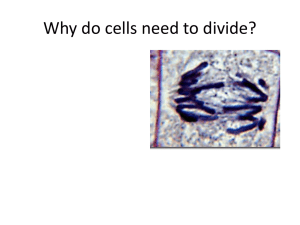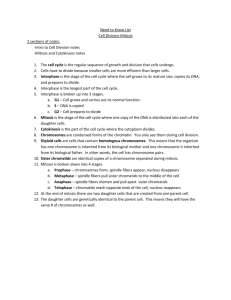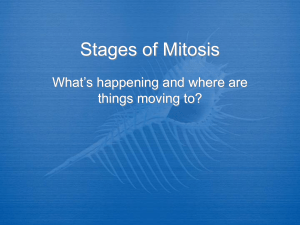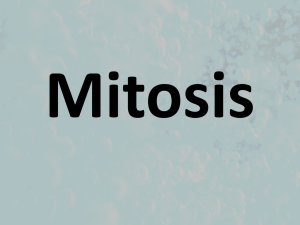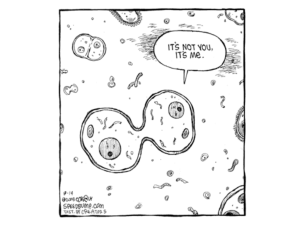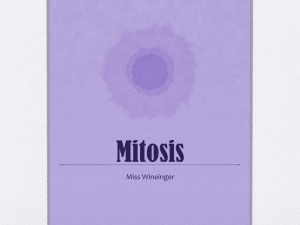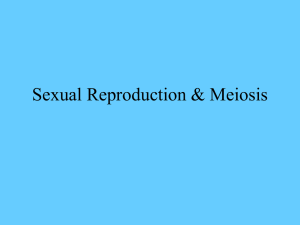The Cell Cycle
advertisement
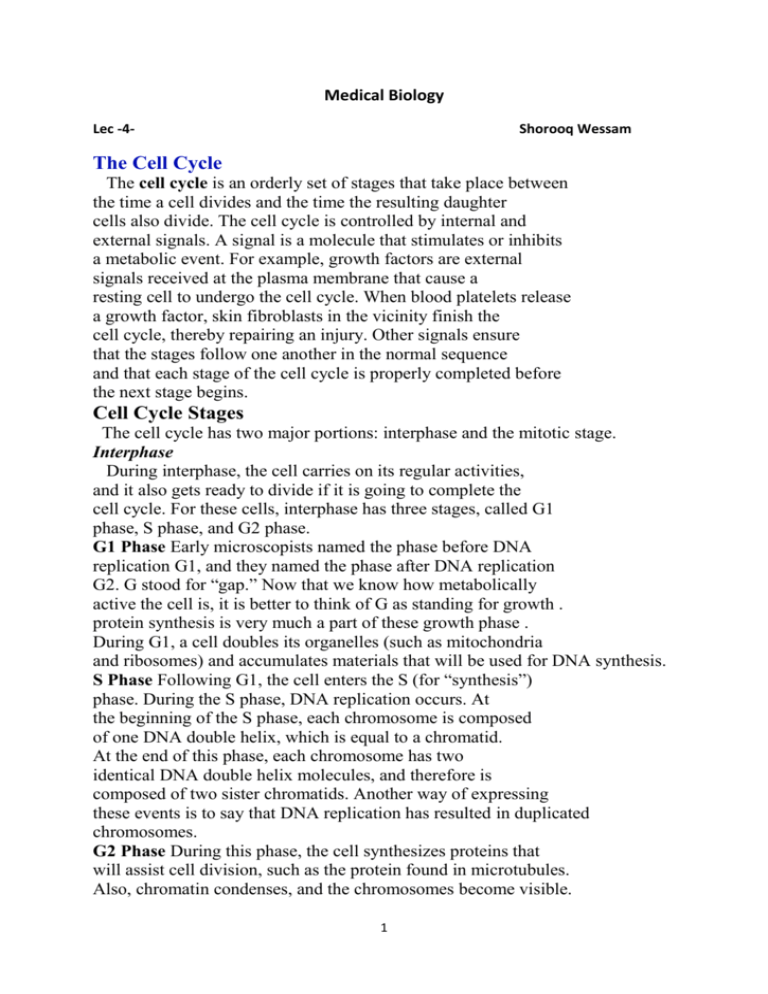
Medical Biology Lec -4- Shorooq Wessam The Cell Cycle The cell cycle is an orderly set of stages that take place between the time a cell divides and the time the resulting daughter cells also divide. The cell cycle is controlled by internal and external signals. A signal is a molecule that stimulates or inhibits a metabolic event. For example, growth factors are external signals received at the plasma membrane that cause a resting cell to undergo the cell cycle. When blood platelets release a growth factor, skin fibroblasts in the vicinity finish the cell cycle, thereby repairing an injury. Other signals ensure that the stages follow one another in the normal sequence and that each stage of the cell cycle is properly completed before the next stage begins. Cell Cycle Stages The cell cycle has two major portions: interphase and the mitotic stage. Interphase During interphase, the cell carries on its regular activities, and it also gets ready to divide if it is going to complete the cell cycle. For these cells, interphase has three stages, called G1 phase, S phase, and G2 phase. G1 Phase Early microscopists named the phase before DNA replication G1, and they named the phase after DNA replication G2. G stood for “gap.” Now that we know how metabolically active the cell is, it is better to think of G as standing for growth . protein synthesis is very much a part of these growth phase . During G1, a cell doubles its organelles (such as mitochondria and ribosomes) and accumulates materials that will be used for DNA synthesis. S Phase Following G1, the cell enters the S (for “synthesis”) phase. During the S phase, DNA replication occurs. At the beginning of the S phase, each chromosome is composed of one DNA double helix, which is equal to a chromatid. At the end of this phase, each chromosome has two identical DNA double helix molecules, and therefore is composed of two sister chromatids. Another way of expressing these events is to say that DNA replication has resulted in duplicated chromosomes. G2 Phase During this phase, the cell synthesizes proteins that will assist cell division, such as the protein found in microtubules. Also, chromatin condenses, and the chromosomes become visible. 1 Mitotic Stage Following interphase, the cell enters the M (for mitotic) stage. This cell division stage includes mitosis (division of the nucleus) and cytokinesis (division of the cytoplasm). During mitosis, daughter chromosomes are distributed to two daughter nuclei. When cytokinesis is complete, two daughter cells are present . Events During the Mitotic Stage The mitotic stage of the cell cycle consists of mitosis and cytokinesis. By the end of interphase , the centrioles have doubled and the chromosomes are becoming visible. Each chromosome is duplicated—it is composed of two chromatids held together at a centromere. As an aid in describing the events of mitosis, the process is divided into four phases: prophase, metaphase, anaphase, and telophase. The parental cell is the cell that divides, and the daughter cells are the cells that result . Prophase Several events occur during prophase that visibly indicate the cell is about to divide. The two pairs of centrioles outside the nucleus begin moving away from each other toward opposite ends of the nucleus. Spindle fibers appear between the separating centriole pairs, the nuclear envelope begins to fragment, and the nucleolus begins to disappear. The chromosomes are now fully visible. Although humans have 46 chromosomes, . Spindle fibers attach to the centromeres as the chromosomes continue to shorten and thicken. During prophase, chromosomes are randomly placed in the nucleus. Structure of the Spindle At the end of prophase, a cell has a fully formed spindle. A spindle has poles, asters, and fibers. The asters are arrays of short microtubules that radiate from 2 the poles, and the fibers are bundles of microtubules that stretch between the poles. Centrioles are located in centrosomes, which are believed to organize the spindle. Metaphase During metaphase, the nuclear envelope is fragmented, and the spindle occupies the region formerly occupied by the nucleus. The chromosomes are now at the equator (center) of the spindle. Metaphase is characterized by a fully formed spindle, and the chromosomes, each with two sister chromatids, are aligned at the equator. Anaphase At the start of anaphase, the sister chromatids separate. Once separated, the chromatids are called chromosomes. Separation of the sister chromatids ensures that each cell receives a copy of each type of chromosome and thereby has a full complement of genes. During anaphase, the daughter chromosomes move to the poles of the spindle. Anaphase is characterized by the movement of chromosomes toward each pole. Function of the Spindle The spindle brings about chromosome movement. Two types of spindle fibers are involved in the movement of chromosomes during anaphase. One type extends from the poles to the equator of the spindle; there, they overlap. As mitosis proceeds, these fibers increase in length, and this helps push the chromosomes apart. The chromosomes themselves are attached to other spindle fibers that simply extend from their centromeres to the poles. These fibers get shorter and shorter as the chromosomes move toward the poles. Therefore, they pull the chromosomes apart . Spindle fibers, as stated earlier, are composed of microtubules. Microtubules can assemble and disassemble by the addition or subtraction of tubulin (protein) subunits. This is what enables spindle fibers to lengthen and shorten, and it ultimately causes the movement of the chromosomes. Telophase and Cytokinesis Telophase begins when the chromosomes arrive at the poles. During telophase, the chromosomes become indistinct chromatin again. The spindle disappears as nucleoli appear, and nuclear envelope components reassemble in each cell. Telophase is characterized by the presence of two daughter nuclei. Cytokinesis is division of the cytoplasm and organelles. In human cells, a slight indentation called a cleavage furrow passes around the circumference of the cell. Actin filaments form a contractile ring, and as the ring gets smaller and smaller, the cleavage furrow pinches the cell in half. As a result, each cell becomes enclosed by its own plasma membrane. 3 4
